“Being young, vigorous, and not afraid to show herself to the multitude, she gained a great influence over the hearts of the people. It was this influence, this force of character, added to a splendid and inspiring courage, that enabled her to offer a desperate resistance to the British…. Whatever her faults in British eyes may have been, her countrymen will ever believe that she was driven by ill-treatment into rebellion; that her cause was a righteous cause. To them she will always be a heroine.”
— “History of the Indian Mutiny” by Sir John Kaye and Colonel George Malleson
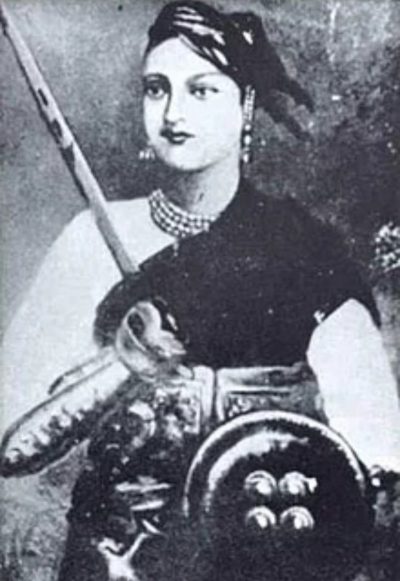 The notion of a warrior woman, who leads the fight against occupying forces is something which quite a common trope of legend and lore worldwide. The family tree includes the likes of Boudicaa in Roman England, through Vietnam’s Trung Sisters, Martha Christina Tiahahu of Indonesia – and, of course, Joan of Arc in France.
The notion of a warrior woman, who leads the fight against occupying forces is something which quite a common trope of legend and lore worldwide. The family tree includes the likes of Boudicaa in Roman England, through Vietnam’s Trung Sisters, Martha Christina Tiahahu of Indonesia – and, of course, Joan of Arc in France.
Lakshmibai is far from unique in Indian history as a warrior woman. The line probably starts with Rudrama Devi, who reigned in her own right over the Kakatiya kingdom for three decades during the late 13th century. In terms of rebellion against the British, who began occupying parts of India from around 1757, Lakshmibai was preceded by Rani Velu Nachiyar. After Nachiyar’s husband was killed in 1772, she raised an army and allied with other monarchs to fight the British.
Half a century later, in 1828, Manikarnika Tambe was born – the girl who would become Rani Lakshmibai. Her mother died when Manu, as she was known, was still a toddler. She was therefore brought up more by her father, who worked for local ruler Baji Rao II. This may explain why her upbringing was non-traditional, Manu learning how to wield a sword, as well as archery and horsemanship. But barely after becoming a teenager, at the age of 13, she was married to the Maharaja of Jhansi, Raja Gangadhar Newalkar. As was tradition, she took a new name: Lakshmibai, in honour of the Hindu goddess of wealth, fortune and prosperity, Lakshmi.
She was not able to provide him with a heir, their only child dying while only a few months old. Instead, shortly before the Maharaja’s death in 1853, they adopted a son. And that’s where Lakshmibai’s problems with the British started. For the British East India Company refused to recognize the adopted son as heir to the throne, applying what was called the ‘Doctrine of Lapse’ and annexing the state of Jhansi to its territories. The following year, Lakshmibai was literally pensioned off, being given a stipend and ordered to leave the palace. Despite this, she does not seem to have initially harboured strong anti-British feelings at this point.
“Her two qualities worth mentioning are her bravery and her generosity. Mostly, she was dressed in male attire. She used to wear a pajama with a vest of dark purple colour. On her head, she wore a turban like cap. On her waist would be a duppatta-like cloth in which a sword would be tucked.”
— Vishnubhat Godse
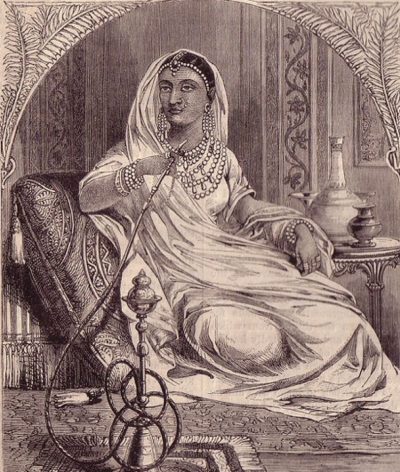 In June 1857, rebel soldiers seized the fort at Jhansi and massacred, not only the officers garrisoned there, but their families. After the rebels left, Lakshmibai took over, running Jhansi on behalf of the British until they could send a superintendent. That’s not exactly Joan of Arc-like… Instead, she fought off efforts by the rebels to claim the Jhansi throne for her husband’s nephew, as well as an attempted invasion by neighbouring states. It’s possible the latter enemy’s alliance with the British helped sour relations between them and Lakshmibai, though she still seems to have intended to act as a caretaker to this point.
In June 1857, rebel soldiers seized the fort at Jhansi and massacred, not only the officers garrisoned there, but their families. After the rebels left, Lakshmibai took over, running Jhansi on behalf of the British until they could send a superintendent. That’s not exactly Joan of Arc-like… Instead, she fought off efforts by the rebels to claim the Jhansi throne for her husband’s nephew, as well as an attempted invasion by neighbouring states. It’s possible the latter enemy’s alliance with the British helped sour relations between them and Lakshmibai, though she still seems to have intended to act as a caretaker to this point.
But clearly something changed her mind. For when the British eventually showed up, in March 1858, she declined to hand over the fort, instead issuing a proclamation: “We fight for independence. In the words of Lord Krishna, we will if we are victorious, enjoy the fruits of victory, if defeated and killed on the field of battle, we shall surely earn eternal glory and salvation.” Brave words, though with hindsight, basically saying, “Come and have a go if you think you’re hard enough,” to the British, at the point of basically peak Empire, might not have been the wisest of tactics…
The British laid siege to Jhansi, and the last hope of rescue ended when an approaching force of 20,000 supporters, under the command of Lakshmibai’s childhood friend, Tatya Tope, was headed off and beaten at the Battle of Betwa River. After ten days, the walls were breached, and the British entered. There is some debate over what happened to the civilian population thereafter. Some reports indicate all were massacred, but Brahmin priest Vishnubhat Godse gave an eye-witness account which said, “All men between the ages of five to thirty were searched out and killed… But the British did not kill women; they stood at a distance from women and told them to hand over whatever gold and jewellery they were wearing.”
Legend states that the queen leapt from the fort on a horse, with her adopted son strapped to her back. Godse’s account is slightly tamer: “She wore male attire, riding shoes and armour covering her whole body. She did not carry even a paisa coin on herself. With a resounding ‘Jai Shankar’ war cry, she descended from the fort and, crossing the city, went out through the north gate. The Company cavalry chased them for about a kos and a half (3 miles). Thereafter, [Lakshmibai]’s horses were no longer in sight.” She regrouped with the remnants of Tatya Tope’s forces, but they were again beaten by Imperial forces, and forced to flee once again.
Two months later, on June 17, she fought her final battle, her army going up against the 8th King’s Royal Irish Hussars. Again, what exactly happened to Lakshmibai has been clouded through the mists of time and folklore. One story says she dressed as a cavalry officer and attacked the hussars; unhorsed, she was wounded, but fought on, firing at her opponent with a pistol, before being shot by his rifle. Godse’s account is almost terse, saying she was “wounded by a bullet, but she continued to fight. Just then, her thigh was wounded with a sword and she fell off the horse. Tatya Tope rushed forward and held her dead body.”
“The high descent of the Rani, her unbounded liberality to her troops and retainers, and her fortitude, which no reverses could shake, rendered her an influential and dangerous adversary.”
— Sir Hugh Rose
 Her post-rebellion legacy was a complex one. Some English writers maligned Lakshmibai, blaming her for the massacre by the rebels at Jhansi – in particular army doctor, Thomas Lowe, who called the queen the “Jezebel of India.” However, Sir Hugh Rose, commander of the British forces who took Jhansi spoke of her in much kinder terms, calling her “Personable, clever and beautiful,” “The most dangerous of all Indian leaders,” and “The bravest and best military leader of the rebels”.
Her post-rebellion legacy was a complex one. Some English writers maligned Lakshmibai, blaming her for the massacre by the rebels at Jhansi – in particular army doctor, Thomas Lowe, who called the queen the “Jezebel of India.” However, Sir Hugh Rose, commander of the British forces who took Jhansi spoke of her in much kinder terms, calling her “Personable, clever and beautiful,” “The most dangerous of all Indian leaders,” and “The bravest and best military leader of the rebels”.
She became a character in a number of English novels, such as The Rane: A Legend of the Indian Mutiny written in 1887 under the pseudonym of “Gillean”, by British officer John Maclean. In it, she seduces an agent of the empire, reinforcing Lowe’s negative depiction. Yet others were more sympathetic, such as Michael White’s Lachmi Bai, Rani of Jhansi, published in 1901. For example, that version of her story absolves Lakshmibai of responsibility for the rebel massacre, blaming a treacherous Muslim associate instead.
In India, of course, there is no such divergence, and she is revered to this day. There are many statues of her, typically on horseback with her son on her back, as the stories depict. She has been honoured in poem and song, and multiple films and TV series. The first was 1953’s Jhansi Ki Rani, released in an English dub three years later as The Tiger and the Flame. The first Technicolor film to be made in India, it was also the most expensive Hindi film made to that point. The makers brought in talent from Hollywood, such as Ernest Haller, Oscar-winning cinematographer for Gone With The Wind, and editor Russell Lloyd, who had also worked with Vivien Leigh, on Anna Karenina in 1948. However, this version proved to be a flop at the box-office.
There have been three television series and two further movies based on the life of the queen. [Some of these adaptations and versions will be reviewed here shortly, and will be listed below] Still to come, and potentially the biggest in the West, is The Warrior Queen of Jhansi, originally titled Swords and Sceptres. In this, Devika Bhise (shown above right) plays Lakshmibai, with Rupert Everett as Sir Hugh Rose, and the supporting cast including Ben Lamb, Derek Jacobi and Jodhi Ma. This picked up distribution through Roadside Attractions in June, and is supposedly scheduled for a fall 2019 release – though no date has been fixed as yet. I’m curious to see how it performs, and if it will help Lakshmibai become as familiar an icon here, as she is in India.
Lakshmibai on the page, screen and TV
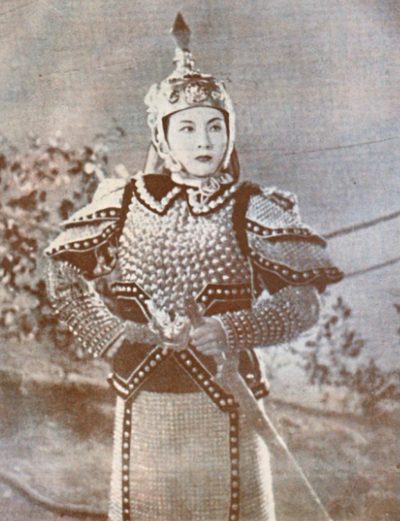 Y’know, considering this is now more than eighty years old, this was likely better than I expected. Chen makes for a solid and engaging heroine, right from the start, when she tricks the residents of a nearby village, who demand she hand over the proceeds of her hunting [I am hoping the dead bird which plummets to the ground with an arrow through it, less than three minutes in, was a stunt avian…]
Y’know, considering this is now more than eighty years old, this was likely better than I expected. Chen makes for a solid and engaging heroine, right from the start, when she tricks the residents of a nearby village, who demand she hand over the proceeds of her hunting [I am hoping the dead bird which plummets to the ground with an arrow through it, less than three minutes in, was a stunt avian…]




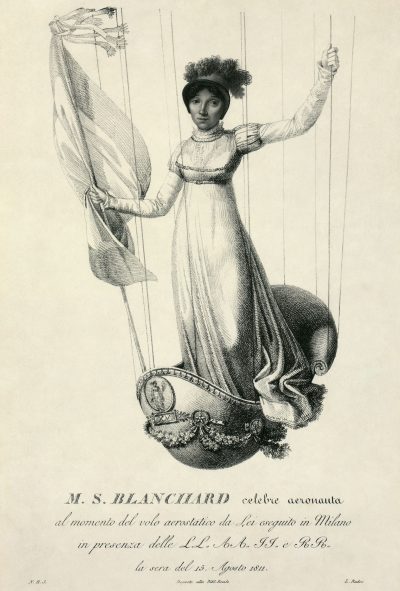 When I
When I 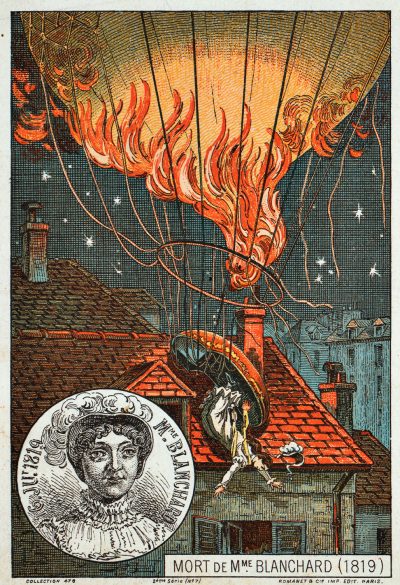 For by this point, the novelty of merely seeing someone slowly ascend into the air had worn a bit thin. The Blanchards needed to jazz their spectacle up a bit to keep the crowds coming back. This included letting off fireworks from the balloon – a hazardous practice, given the inflammable nature of both the balloon and its gaseous contents – and tossing dogs out of the basket. Attached to those then recently-invented parachutes, I should add.
For by this point, the novelty of merely seeing someone slowly ascend into the air had worn a bit thin. The Blanchards needed to jazz their spectacle up a bit to keep the crowds coming back. This included letting off fireworks from the balloon – a hazardous practice, given the inflammable nature of both the balloon and its gaseous contents – and tossing dogs out of the basket. Attached to those then recently-invented parachutes, I should add. These exhibitions were not without incident. She flew over the Alps, and some of her flights lasted as long as 14½ hours, reaching a height of over 12,000 feet. At that height, the environment was so cold, icicles formed on her face, and she was in danger of passing out due to a lack of oxygen. In 1817, she almost drowned when her selected landing-spot turned out to be a marsh, and she became caught up in her craft’s rigging after touchdown. Only the fortuitous arrival of assistance saved her from a watery grave. However, it was only a stay of execution, rather than a pardon.
These exhibitions were not without incident. She flew over the Alps, and some of her flights lasted as long as 14½ hours, reaching a height of over 12,000 feet. At that height, the environment was so cold, icicles formed on her face, and she was in danger of passing out due to a lack of oxygen. In 1817, she almost drowned when her selected landing-spot turned out to be a marsh, and she became caught up in her craft’s rigging after touchdown. Only the fortuitous arrival of assistance saved her from a watery grave. However, it was only a stay of execution, rather than a pardon. I try and not let my expectations influence my reviews: a movie deserves to be judged on what it is, rather than what I expected it to be. A film-maker usually doesn’t get to decide, for instance, the DVD sleeve. But when you invoke the name of Boudica in your title, this creates certain requirements with regard to your content, especially when combined with the words “warrior queen.” These are requirements which this movie is utterly incapable of meeting. Technically, the word “rise” is probably the only accurate element to be found, on the cover, which certainly counts as among the most inaccurate in recent memory.
I try and not let my expectations influence my reviews: a movie deserves to be judged on what it is, rather than what I expected it to be. A film-maker usually doesn’t get to decide, for instance, the DVD sleeve. But when you invoke the name of Boudica in your title, this creates certain requirements with regard to your content, especially when combined with the words “warrior queen.” These are requirements which this movie is utterly incapable of meeting. Technically, the word “rise” is probably the only accurate element to be found, on the cover, which certainly counts as among the most inaccurate in recent memory. Not unlike the saga of
Not unlike the saga of 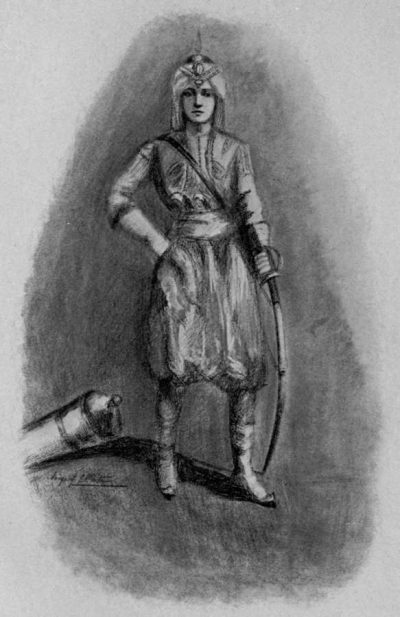
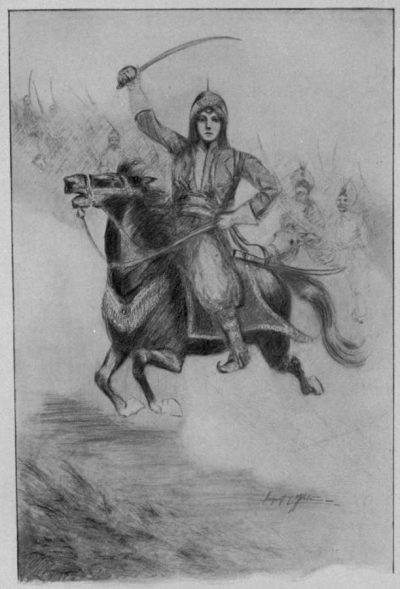
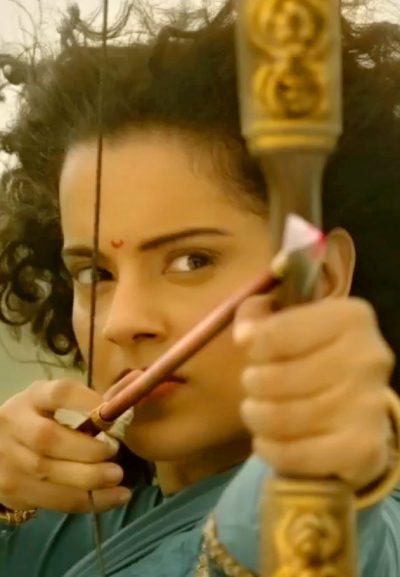 The movie opens with a particularly elaborate disclaimer, admitting that “certain cinematic liberties have been sought,” and that “this film does not claim historical authenticity.” Probably wise: Indians take their national heroes very seriously; just last year, another historical epic, Padmaavat,
The movie opens with a particularly elaborate disclaimer, admitting that “certain cinematic liberties have been sought,” and that “this film does not claim historical authenticity.” Probably wise: Indians take their national heroes very seriously; just last year, another historical epic, Padmaavat, 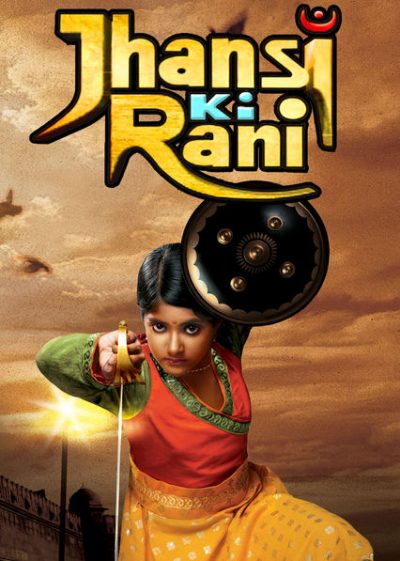 Not for the show, I should stress. But as a Brit… Wow, were were really such utter bastards to the Indians when the country was a colony? I was under the impression it was all tea and cricket. But the British, as depicted here, appear largely to be working entirely for the East Indian company, treating the local population with, at best, disdain, and often brutality. All the while, seeking to manipulate local politics (with, it must be said, the help of some Indians) to their own advantage. After 70 episodes of this, such is the guilt, I can barely enjoy my chicken tikka masala without giving it reparations.
Not for the show, I should stress. But as a Brit… Wow, were were really such utter bastards to the Indians when the country was a colony? I was under the impression it was all tea and cricket. But the British, as depicted here, appear largely to be working entirely for the East Indian company, treating the local population with, at best, disdain, and often brutality. All the while, seeking to manipulate local politics (with, it must be said, the help of some Indians) to their own advantage. After 70 episodes of this, such is the guilt, I can barely enjoy my chicken tikka masala without giving it reparations. The British – already unhappy with Manu’s rebellious outbursts – are far from happy at the prospect of her marrying Gangadhar and continuing the line. Even before she arrives at the palace, there are backroom conspiracies involving some of his relatives (not least his own mother), who ally themselves with the colonialists for their mutual benefit. These schemes go up to and include multiple assassination plots against the king, and indeed, his bride-to-be. Time for Kranti Guru to come out again, particularly to face off against gold-toothed British psychopath Marshall (Verma). His relentless pursuit, without regard for who gets hurt, earns him Manu’s undying enmity. [Weirdly, he’s played by an Indian actor in “white face”, as are some – but not all – of the other English officers, some of whom are dubbed.]
The British – already unhappy with Manu’s rebellious outbursts – are far from happy at the prospect of her marrying Gangadhar and continuing the line. Even before she arrives at the palace, there are backroom conspiracies involving some of his relatives (not least his own mother), who ally themselves with the colonialists for their mutual benefit. These schemes go up to and include multiple assassination plots against the king, and indeed, his bride-to-be. Time for Kranti Guru to come out again, particularly to face off against gold-toothed British psychopath Marshall (Verma). His relentless pursuit, without regard for who gets hurt, earns him Manu’s undying enmity. [Weirdly, he’s played by an Indian actor in “white face”, as are some – but not all – of the other English officers, some of whom are dubbed.]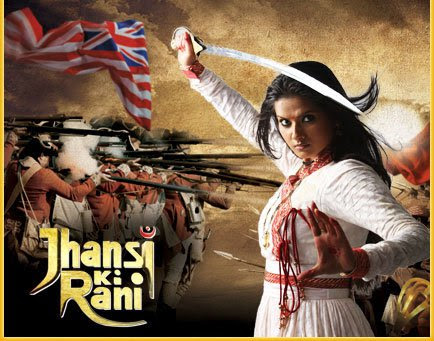 For the great majority of the time, it’s light stuff, with Manu escaping every pitfall her enemies set for her. Then, the hammer drops: to extend the GoT comparison, it’s the Rani equivalent of the Red Wedding. Fewer bodies, to be sure – just one – yet the resulting emotional wallop was still brutal, sending me through multiple stages of grief during the subsequent fall-out. “No… Surely they haven’t… It’s got to be a dream sequence.” All told, it was easily the most impactful death in any of the telenovelas I’ve watched, regardless of their origin, and the repercussions ran on for multiple episodes. As do the reaction shots. So. Many. Reaction. Shots.
For the great majority of the time, it’s light stuff, with Manu escaping every pitfall her enemies set for her. Then, the hammer drops: to extend the GoT comparison, it’s the Rani equivalent of the Red Wedding. Fewer bodies, to be sure – just one – yet the resulting emotional wallop was still brutal, sending me through multiple stages of grief during the subsequent fall-out. “No… Surely they haven’t… It’s got to be a dream sequence.” All told, it was easily the most impactful death in any of the telenovelas I’ve watched, regardless of their origin, and the repercussions ran on for multiple episodes. As do the reaction shots. So. Many. Reaction. Shots.
 The notion of a warrior woman, who leads the fight against occupying forces is something which quite a common trope of legend and lore worldwide. The family tree includes the likes of
The notion of a warrior woman, who leads the fight against occupying forces is something which quite a common trope of legend and lore worldwide. The family tree includes the likes of  In June 1857, rebel soldiers seized the fort at Jhansi and massacred, not only the officers garrisoned there, but their families. After the rebels left, Lakshmibai took over, running Jhansi on behalf of the British until they could send a superintendent. That’s not exactly Joan of Arc-like… Instead, she fought off efforts by the rebels to claim the Jhansi throne for her husband’s nephew, as well as an attempted invasion by neighbouring states. It’s possible the latter enemy’s alliance with the British helped sour relations between them and Lakshmibai, though she still seems to have intended to act as a caretaker to this point.
In June 1857, rebel soldiers seized the fort at Jhansi and massacred, not only the officers garrisoned there, but their families. After the rebels left, Lakshmibai took over, running Jhansi on behalf of the British until they could send a superintendent. That’s not exactly Joan of Arc-like… Instead, she fought off efforts by the rebels to claim the Jhansi throne for her husband’s nephew, as well as an attempted invasion by neighbouring states. It’s possible the latter enemy’s alliance with the British helped sour relations between them and Lakshmibai, though she still seems to have intended to act as a caretaker to this point. Her post-rebellion legacy was a complex one. Some English writers maligned Lakshmibai, blaming her for the massacre by the rebels at Jhansi – in particular army doctor, Thomas Lowe, who called the queen the “Jezebel of India.” However, Sir Hugh Rose, commander of the British forces who took Jhansi spoke of her in much kinder terms, calling her “Personable, clever and beautiful,” “The most dangerous of all Indian leaders,” and “The bravest and best military leader of the rebels”.
Her post-rebellion legacy was a complex one. Some English writers maligned Lakshmibai, blaming her for the massacre by the rebels at Jhansi – in particular army doctor, Thomas Lowe, who called the queen the “Jezebel of India.” However, Sir Hugh Rose, commander of the British forces who took Jhansi spoke of her in much kinder terms, calling her “Personable, clever and beautiful,” “The most dangerous of all Indian leaders,” and “The bravest and best military leader of the rebels”. This 1986 TV movie was the first film made about an FBI agent while they were still active. Gibson was the fifth black female agent in the bureau’s history: she broke new ground by being the first such assigned to the Fugitive Matters department in the Miami branch, and was also the first to reach a supervisory level within the FBI. That would, however, be well after the story told in this film. It covers how she came to join the FBI, and her first major undercover operation, taking down a gun-running ring operated by ex-NFL star, Adam Prentice (Lawson). However, Gibson starts to find the lines between real-life and undercover work blurring, and begins feeling genuine affection for her target. This doesn’t sit well with her partner, TC (Rollins). If it sounds all very by the numbers… It is.
This 1986 TV movie was the first film made about an FBI agent while they were still active. Gibson was the fifth black female agent in the bureau’s history: she broke new ground by being the first such assigned to the Fugitive Matters department in the Miami branch, and was also the first to reach a supervisory level within the FBI. That would, however, be well after the story told in this film. It covers how she came to join the FBI, and her first major undercover operation, taking down a gun-running ring operated by ex-NFL star, Adam Prentice (Lawson). However, Gibson starts to find the lines between real-life and undercover work blurring, and begins feeling genuine affection for her target. This doesn’t sit well with her partner, TC (Rollins). If it sounds all very by the numbers… It is.